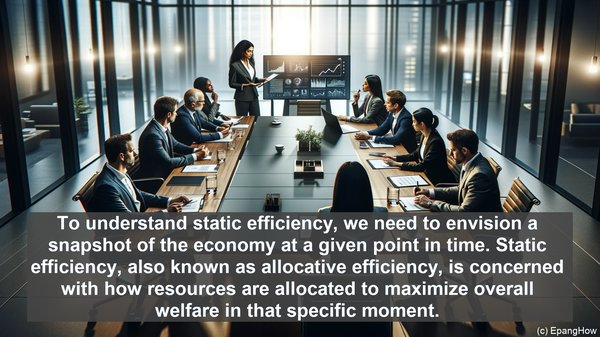Introduction: Efficiency as the Cornerstone of Economics
Hello everyone, and welcome to today’s article. When we talk about economics, one of the key aspects that often comes up is efficiency. It’s a concept that lies at the heart of economic theories and policies. Today, we’ll be focusing on two specific types of efficiency: dynamic efficiency and static efficiency. While both are crucial, they differ in their time horizons and the factors they consider. So, let’s dive in and explore the nuances of these two concepts.
Static Efficiency: The Present Picture
To understand static efficiency, we need to envision a snapshot of the economy at a given point in time. Static efficiency, also known as allocative efficiency, is concerned with how resources are allocated to maximize overall welfare in that specific moment. It’s about achieving the optimal allocation of resources, where no reallocation can make one individual or group better off without making another worse off. In other words, it’s about achieving the highest possible level of efficiency with the existing resources, without considering changes over time.
Dynamic Efficiency: The Focus on the Future
While static efficiency looks at the present, dynamic efficiency takes a more forward-looking approach. It’s concerned with the efficiency of resource allocation over time, taking into account changes, innovations, and technological advancements. Dynamic efficiency is about continuously improving the allocation of resources, ensuring that they are used in the most productive and beneficial ways as the economic landscape evolves. It’s a concept closely tied to the idea of economic growth and progress.
The Trade-Off: Dynamic vs. Static Efficiency
In an ideal world, achieving both dynamic and static efficiency simultaneously would be the goal. However, in reality, there’s often a trade-off between the two. The pursuit of dynamic efficiency, with its focus on innovation and long-term growth, may require short-term sacrifices in static efficiency. For example, investing in research and development or adopting new technologies may initially lead to inefficiencies, but in the long run, they can drive economic progress and higher levels of overall welfare.

Real-World Examples: Dynamic and Static Efficiency in Action
To better understand these concepts, let’s consider a couple of real-world examples. Take the automotive industry. Achieving static efficiency would mean producing vehicles at the lowest possible cost, ensuring affordability for consumers. However, dynamic efficiency would involve investing in research and development to improve fuel efficiency, safety features, and overall performance. Similarly, in the energy sector, while static efficiency would focus on optimizing existing energy sources, dynamic efficiency would involve exploring and investing in renewable and sustainable alternatives.

